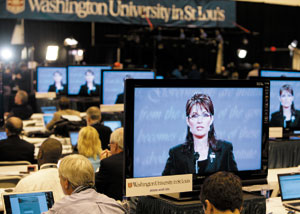The excitement surrounding this year’s presidential election and vice presidential candidates brought more than twice as many journalists to campus to cover the vice presidential debate as arrived in 2004 for the presidential debate.
About 3,100 journalists received credentials to cover the historic debate between Sen. Joe Biden and Gov. Sarah Palin, the first female Republican vice presidential candidate.

Among the national broadcast reporters or anchors spotted in the Athletic Complex were Katie Couric of CBS; Bob Schieffer, CBS News chief Washington correspondent; Chris Wallace, Greta Van Susteren and Shepard Smith of FOX News; Dana Bash, Candy Crowley and Suzanne Malveaux of CNN; Tucker Carlson of MSNBC; Howard Fineman of Newsweek; Mark Halperin of Time; and John Oliver of “The Daily Show with Jon Stewart.”
More than 600 journalists set up on rows of tables in the Media Filing Center in the Recreational Gymnasium on the lower level of the Athletic Complex.
The major television and cable networks did live broadcasts from 45 outdoor stand-up locations just outside the front entrance of the Athletic Complex.
To support the influx of media, AT&T installed 1,600 voice and data lines and 53 miles of fiber-optic cable lines, laid nearly eight miles of electrical cable in the Athletic Complex and provided enough fiber for 11 live video broadcasts.
To handle the cellular phone traffic, four “cellular on wheels” trucks were brought in to support AT&T, Verizon, Sprint and T-Mobile cellular services.
Before the start of the debate, media circulated throughout the venue doing live broadcasts, checking e-mail and preparing stories, while other media staff set up thousands of lights, ran miles of cables and even played cards on the floor of the media filing room. But media members said the debate was exciting for one main reason: Palin.
“This is the most exciting vice presidential debate because of Sarah Palin,” said Crowley, senior political correspondent for CNN. “People don’t vote for the No. 2 spot, but if you’ve got someone going back and forth, a debate can make a difference.”
Crowley, who was recuperating from a respiratory illness, flew to St. Louis Thursday morning after covering the Senate vote on the bailout bill Wednesday night. “But I said, ‘No matter what, I’m getting on that plane (to St. Louis) Thursday.'”
Crowley said CNN had four correspondents on site and a total of 50 staff. The cable network was also providing the pooled audio and video feed to affiliate stations nationwide.
Susan Davis, a reporter for the Wall Street Journal, said she has been covering the primary debates since last fall but was looking forward to the Biden-Palin debate.
“All expectations are on Palin,” Davis said. “If she does horribly, it’s a great story. If she does great, it’s a great story. This will be a fun one to watch.”
Nancy Karibjanian, senior contributor for WHYY of Wilmington, Del., a PBS and National Public Radio affiliate, said she has been waiting since 1987 to cover a debate.
“As a public television station from Delaware, we wouldn’t normally get to be here, but since we have a representative on the panel, we get to cover it,” Karibjanian said.
Local media were also in force, taking in the spectacle of the “media circus” but admitting the event was exciting.
Todd Frankel, a reporter with the St. Louis Post-Dispatch, was among seven Post-Dispatch reporters and several Post-Dispatch photographers on hand.
“This is almost too much,” Frankel said. “There are 3,100 journalists covering two people, but it’s always more fun to cover a circus.”
Jeff Small, a reporter with KDSK in St. Louis, was doing stories about the security around campus and about ticketholders’ reactions to the debate.
“This is really impressive, especially how the University and the Commission on Presidential Debates have pulled this off — kudos to everybody,” he said. “Even though I work in the media, it’s fascinating to see everyone here.”
Major television networks that had a podium in the debate hall were ABC, CBS, NBC, CNN, C-SPAN and FOX News. About 42 network and affiliate trucks were on hand.
Print media on hand included The New York Times, USA Today, Wall Street Journal Associated Press, Houston Chronicle, Denver Post, Tucson Citizen, Austin American-Statesman and the Fairbanks Daily News-Miner.
Radio networks included National Public Radio, Westwood One/CBS Radio News and Radio-Canada.
Around campus, where there were cameras, there were students. CBS’ “The Early Show” broadcast live on the mornings of Oct. 2 and 3 from both inside Holmes Lounge in Ridgley Hall and outside of Holmes Lounge.
MSNBC broadcast live throughout the day on the lawn outside of Graham Chapel with NBC News’ Political Director Chuck Todd, Chief Foreign Affairs Correspondent Andrea Mitchell and “Hardball with Chris Matthews” throughout the evening.
CNN broadcast live from the Danforth University Center, and ABC NewsOne broadcast live from 11 a.m. Oct. 2 until 2 a.m. Oct. 3 from outside of the Lab Sciences Building.